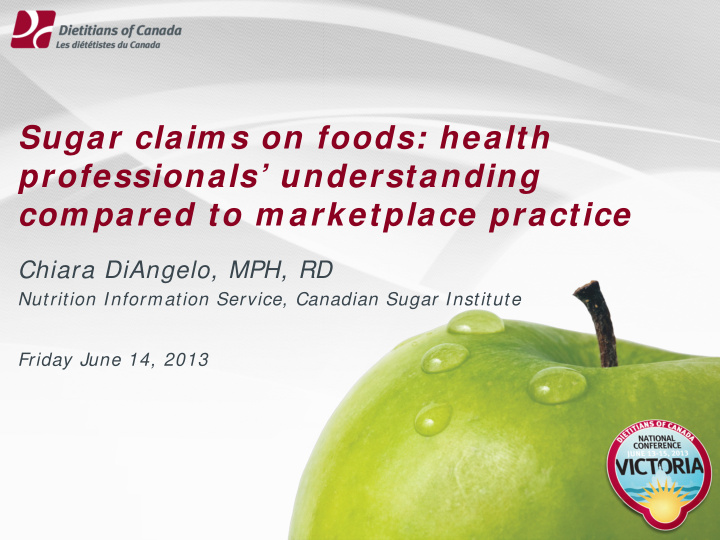



Sugar claim s on foods: health professionals’ understanding com pared to m arketplace practice Chiara DiAngelo, MPH, RD Nutrition Information Service, Canadian Sugar Institute Friday June 14, 2013
Canadian Sugar Institute Nutrition Information Service • Inform and educate Canadians about sugars and healthy eating and advocate for science-based nutrition policies Staffed by nutrition professionals: • – Sandra Marsden, MHSc, RD, President – Tristin Brisbois, PhD, Manager Nutrition & Scientific Affairs – Chiara DiAngelo, MPH, RD, Coordinator Nutrition Communications • Guided by Scientific Advisory Council: – G. Harvey Anderson, PhD, University of Toronto – David D. Kitts, PhD, University of British Columbia – Huguette Turgeon-O’Brien, PhD, RD, Laval University – Bob Ross, PhD, Queen’s University – Joanne Slavin, PhD, RD, University of Minnesota
Background • Nutrient content claims are meant to help consumers make informed dietary choices. • For food and beverages bearing a sugar claim, comparative reductions in carbohydrates and calories are required for changes to have nutritional significance. • All carbohydrates (including naturally occurring and added sugars) contribute 4kcal/g. • Sugar claims may not be useful if: Consumer expectations are not met (e.g. “no added • sugar” does not mean “no sugar”) ; Benefits are misinterpreted (e.g. for people with • diabetes) ; Products do not comply with Canadian Food Inspection • Agency (CFIA) criteria.
Sugars Terminology (Canada) Terminology Sucrose (from sugar cane or sugar beets). Canadian food standards specify that sugar must have a minimum Sugar purity of 99.8 % sucrose. All sugars added to foods, including sugar and sugar syrups, honey, maple syrup, and corn sweeteners (high Added Sugars fructose corn syrup (“glucose-fructose”), glucose syrup, and dextrose). All monosaccharides (glucose, fructose, galactose) and Total Sugars disaccharides (sucrose, lactose, maltose) occurring in foods (e.g., milk, fruit and vegetables) or added to foods ( see “added sugars”).
Canadian Food Inspection Agency (CFIA) compositional criteria for sugar claims on foods Claim Conditions – Food • Food is modified so it contains at least 25% less Reduced in sugar(s) sugars, totalling at least 5g less per reference “reduced in sugar”; “sugar-reduced” amount compared to similar reference food*. • Food contains at least 25% less sugars, totalling Lower in sugar(s) at least 5g less per reference amount compared “less sugar”; “lower sugar” to similar reference food. • Food contains no added sugars, ingredients containing added sugars, or ingredients that No added sugar(s) functionally substitute for added sugars. “no added sugar”; • Sugars content is not increased through some “without added sugar” other means. • Similar reference food contains added sugars. • Food meets conditions for “no added sugars” Unsweetened and does not contain non-caloric sweeteners. * “Similar reference food" means a food of the same type as the food to which it is compared and that has not been processed, formulated, reformulated or otherwise modified in a manner that increases or decreases either the energy value, or the amount of a nutrient that is the subject of the comparison. Reference: CFIA 2013. http://www.inspection.gc.ca/english/fssa/labeti/guide/ch7be.shtml
Objectives 1. To assess health professionals’ understanding of sugar claims (“reduced in sugar”, “no sugar added”, “unsweetened”); 2. To compare calories, carbohydrates, and sugars content between claim and reference products in the market place; and 3. To determine the level of compliance with CFIA criteria among sugar claim products.
Methods 1. Survey of Health Professionals – Voluntary questionnaires completed at two National conferences Surveys assessed understanding and expectations of sugar – claims. 2. Marketplace Research – Four Toronto grocery stores were surveyed (June-August 2012). Information on sugars, calories, and carbohydrates were – collected for both claim and reference products; and reductions in sugars, calories and carbohydrate were calculated. – Products were assessed for compliance with CFIA criteria. Microsoft Office Excel 2007 was used to conduct all analyses. •
Health Professionals’ Expectations and Understanding of Sugar Claims on Foods and Beverages • Questionnaires were completed by 442 respondents: dietitians (43%); nurses (22%); other health professionals (29%). “Reduced in Sugar” claims: • 2/3 of respondents expected calories to be reduced along with sugars; • 1/3 expected calories to be reduced by 25%. “No Added Sugar” claims: • 43% of respondents expected calories to be reduced; • 57% incorrectly thought concentrated fruit juice could be added as a sweetener; • <15% knew naturally-occurring sugars could be present.
Sugar Claims on Foods Do Not Meet Health Professionals’ Expectations Sugar Claim Products in the Marketplace: Figure 1: Percent of food products bearing sugar claims that did not have a 25% reduction in calories. • 402 products had a sugar claim. • 38% of products were not reduced in calories by >25% as expected by health professionals: • 15% of products were higher in calories ; • 18% were higher in carbohydrates ; and • 6% were higher in sugars compared to reference products.
Sugar Claims in the Marketplace in Comparison to CFIA Guidelines REDUCED SUGAR CLAIMS % sugar reduction Figure 2: "Reduced in sugars" actual vs. claimed reduction in sugars content Met or Exceeded Did Not Meet 70% 60% • One-third of “reduced in sugar” products did not meet the % sugar reduction claimed on 50% the package. 66% 40% 30% 34% 20% 10% 0% Products
Sugar Claims in the Marketplace in Comparison to CFIA Guidelines SUGAR CLAIMS Compliance with CFIA criteria • <40% of products complied with CFIA criteria: – Absence of an appropriate reference product (n=141); – Incorrect use of concentrated fruit juice as a sweetener in “no sugar added” products (n=99).
Conclusions • Overall, the nutritional composition of products bearing a sugar claim did not meet health professionals’ expectations. • Sugar claims may be misleading if used incorrectly or if there is not a meaningful reduction in calories. • The perception that sugar claim products are free of sugars and/or lower in carbohydrates may be of concern for people with diabetes. “Lower in carbohydrates” “Lower in calories” “No sugar”
Questions? Chiara DiAngelo, MPH, RD Coordinator, Nutrition Communications Canadian Sugar Institute cdiangelo@sugar.ca www.sugar.ca
Recommend
More recommend